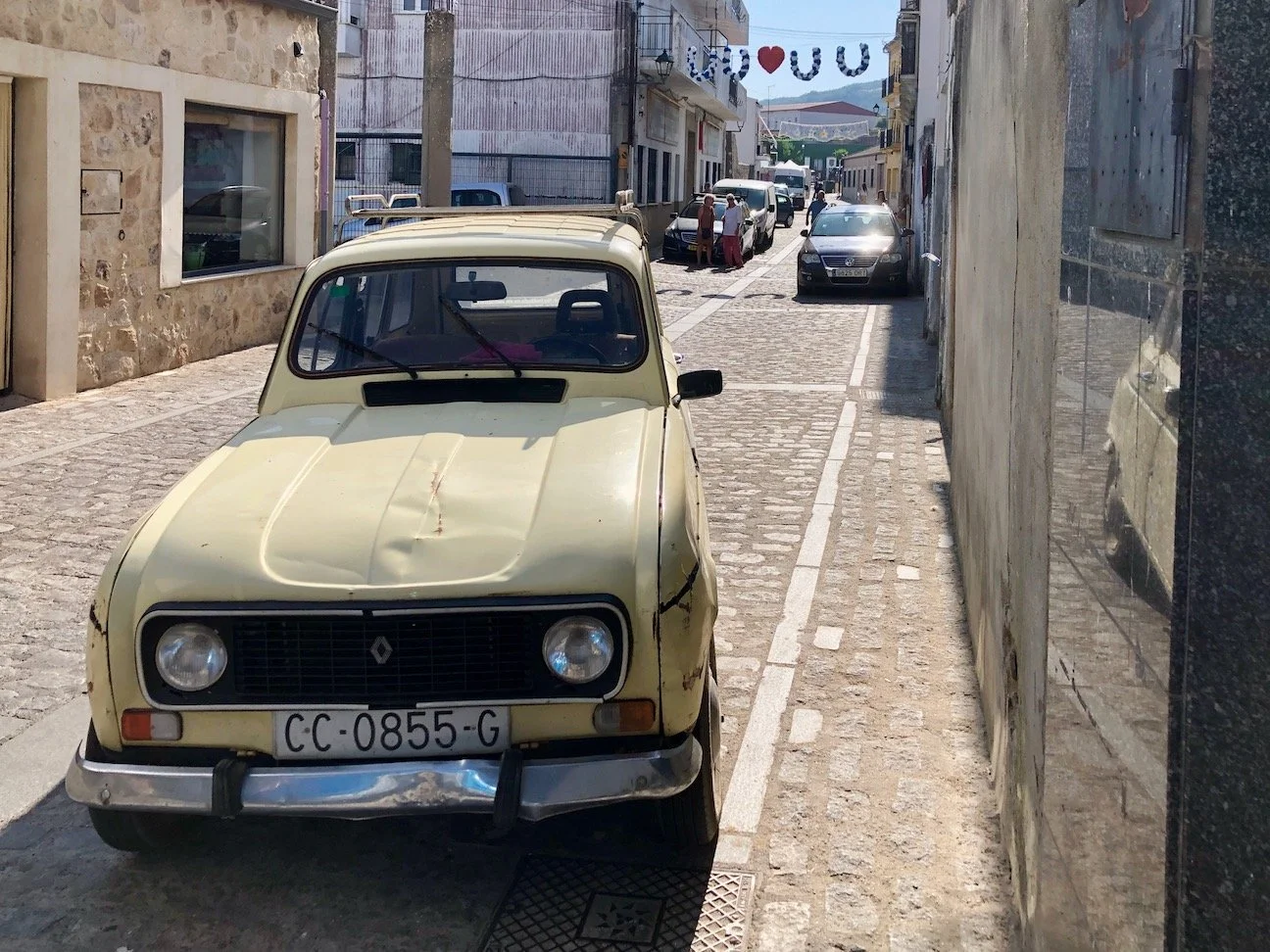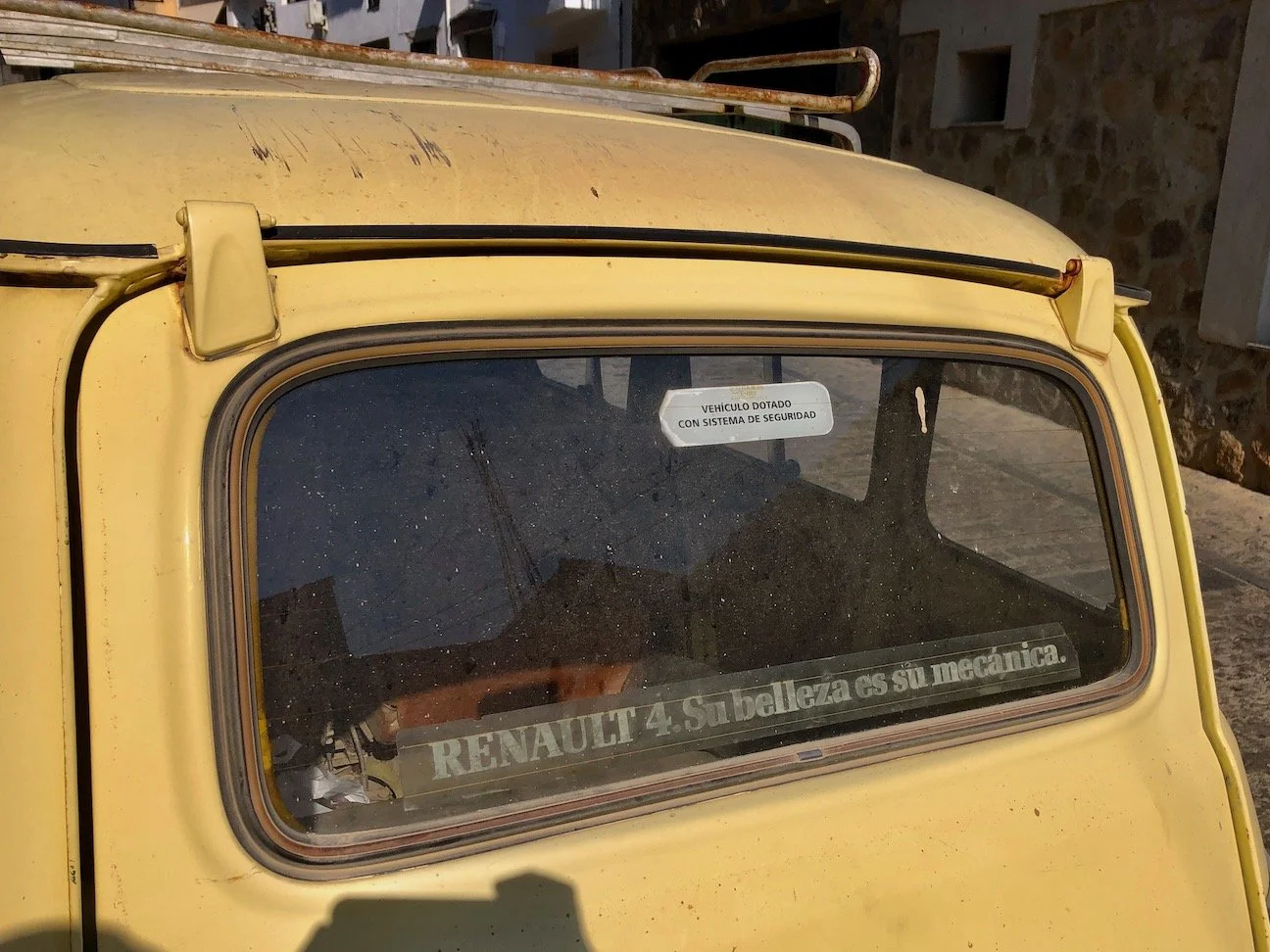On not breaking eggs driving over a ploughed field
We are renting a car from Hertz. It tweaks the steering wheel to keep me in lane. It pings in one tone when I exceed a speed limit and it bleats in another as I drive down a country lane, blades of grass on either side threatening potential impact. By today’s standards this car is nothing fancy, a Volkswagen Taigo, utterly ‘normal’. It is not electric or hybrid, nothing that smacks of new forms. What is striking about this 2025 version of a well-designed ‘normal’ car however, is the sophistication of its engineering, in particular its electronics.
VW Taigo flight control deck
No sooner is the engine activated and we are on our way than the driver is overwhelmed with visual information on the dashboard (kmh, rpm, liters/per 100K, oil and outside air temperatures etc.) and then the aural pinging and bleating that goes on, safety alerts, signifiers of the nanny state. There is also data collection on driving behaviour indicating location, speeding, braking, swerving and other potential delinquencies. To whom are the data delivered? To Hertz, to VW, to some national agency or possibly a subcontractor?
On top of this information there is an array of choices as to which feature one would like to activate — the parking ‘ping’; the speeding ‘ping’; the steering auto-correction tug at the wheel; trip duration; tire pressure; and information showing the rate of fuel consumption, in the moment or on average. There are of course the standard direction indicators, windshield wipers and washers (front and rear), hazard warnings, and high and low beam switches, and there is the adjustment by touch of the heating and air conditioning, front or back, left or right, feet or head. As further distraction, there is the ‘in-vehicle entertainment system’ with its own battery of commands.
A modern gasoline vehicle of this standard variety will have anything between 300 to 1,000 computer chips incorporated to make it function. Electric vehicles may have up to 3,000. In addition to the driver information systems and dashboard controls, chips are incorporated into ignition, alternator, compressor, fuel injection, fuel pump and suspension and myriad other systems essential to the vehicle’s functioning.
No doubt all this technological and electronic sophistication makes for reliability, efficiency, comfort and safety. It also makes the production and maintenance of a modern vehicle, costly and precarious, highly dependent on supply chains and manufacturers’ market dominance. The Covid-19 pandemic in 2020 created a major interruption to the global supply of computer chips. That already existing shortage was exacerbated and vividly illustrated when the Ever Given container ship managed to get itself wedged between two sides of the Suez Canal in March 2021. The ship remained stuck for six days causing a pile up of 369 ships at a cost of $9.6 billion per day. The chip shortage and subsequent intermittent interruptions (including those caused by drought in Taiwan) resulted in a doubling of delivery times and a massive slowdown in vehicle production in Europe and North America at least through 2023.
I am dreaming of the Renault 4 we drove in Kenya in the 1970’s. This vehicle was marketed in East Africa as the ‘Roho’, Swahili for ‘soul’. Well named. We could stuff half a dozen children into it for the school run. We could take it on safari on corrugated murram roads. If a thorn should penetrate the tire (a frequent occurrence) a couple of helpers could lift it up to rest on a stone or log and change the wheel with no effort. Most importantly, whenever something went wrong, we could take it to Govind, a roadside mechanic on the Ngara road, and he could fix it. The timing, the carburetor, the expansion bottle, an electrical relay, the clutch, the ball joints, even a ‘head job’ were all in his repertoire. In Nairobi, having one’s headlights redistributed by parking boys was an urban hazard that had to be dealt with. Govind could find substitutes from a scrap dealer — who in all likelihood had received the items from the felons themselves, a creative variation on the circular economy. But to ensure there was no repetition, Govind developed an aluminum strap neatly pop-riveted to the body.
Manolo’s Renault 4 in Montánchez, Extremadura, Spain. August 2025
Govind, as competent, reliable and affable as he was, was in fact one of many such roadside mechanics in the city. When he was inundated with work, he directed us to Shaukat, an Ismaili who not only fixed our cars — we also had a 1966 Volvo 122S — but also explained the Ismaili system of tithes and good works to me. He now lives in Toronto. And then there was Fabrizio, a former Italian prisoner of war who when he was released from an internment camp decided to stay in Kenya, married a Kikuyu woman and set up business as a mechanic. These men, without formal education, were incredibly good at their jobs and remarkably resourceful in making things work in a place of scarce resources.
Some years ago two Boston doctors working in Tanzania witnessed in despair the sophisticated medical equipment that had to be put aside for lack of spare parts, or lack of maintenance expertise. Having observed the skills of the roadside mechanics in Dar es Salaam, they designed an incubator made entirely of Toyota parts. The headlights provided heat, the fans provided ventilation and relays would connect these to the thermostat. Not only were Toyota parts ubiquitous and cheap, every mechanic in the country could work with them. Newborn babies in the NICU could rest assured of a comfortable and restorative environment.
A Citroën 2CV in a museum
A precursor to the Roho and to the current universality of Toyotas, was the Citroën 2CV. Conceived by Citroën vice president Pierre Boulanger in the 1930’s, it only went into production after the end of the World War. The original was 9HP but taxed as only two taxable horses. Boulanger’s design parameters were themselves a work of genius. The car was designed for poor rural farmers as “an umbrella on wheels”. It should be able to accommodate four people with a pig in the back (maximum weight 50kg) and a sack of corn on the return journey. The suspension was designed for the car to travel over a ploughed field with a carton of eggs on the front seat without smashing them. The front-mounted air cooled two-cylinder engine was to consume only 3 liters of gasoline for every 100kms (i.e. 80 mpg US) and achieve a top speed of 65kph. The “umbrella” had a canvas top and every panel of the bodywork was detachable and replaceable. As the German Volkswagen (designed by Dr. Porsche) and the Italian Fiat Cinquecento reflected their national characteristics, the Citroën was unmistakably French.
A 2CV being loaded up with baguettes. Not in a museum.
These cars were built in times of economic scarcity in Europe and were designed for rural families living on modest incomes. In addition to the physical design features an essential attraction of these cars is that they were easily maintained by the owner with parts and supplies that were cheap and readily available. This was also true of the Ford Model T, of the Morris Minor and Mini, of Massey Harris and Ferguson tractors. All of these machines were accessible and fixable by any reasonably competent mechanic with a wrench.
But gone are the days when even I could change the spark plugs, set the points or dry out the distributor on a Mini. Gone are the days of the Roho bouncing merrily over atrocious roads, to check up on a building site, knowing that if anything went wrong there would be someone at my destination who could fix it.
Today and for the last few years, we have painted ourselves into a corner defined on the one side by a supply chain vulnerable to failure and on the other by a technology accessible only to a highly capital-intensive operations and maintenance regimen.
Supply chain vulnerability could be reduced by consolidating production chains geographically, by bringing chip production closer to wherever final production and assembly takes place — bringing Taiwan closer to Detroit, so to speak. Which, one might suppose, is what the current US administration is attempting to do in a crude way.
On a more fundamental level however, this vulnerability — what Thomas Fisher calls ‘fracture critical’ design — could be overcome by ensuring that the failure of one component in a system does not result in collapse but can be resolved by the remaining components or by a workaround, a principle known in design as redundancy. The spare wheel in any car is a good example of redundancy in which one component fails and is easily replaced by another (the spare). A car with a manual shift can be started in cold weather by pushing it or rolling it downhill in gear and letting in the clutch. This is not possible with automatic. Or, on models as late as the 1950’s, if the self-starter or the battery failed, a starting handle would do the trick.
This brings us to the concept of mechanical open access. This idea is something that farmers in particular have been campaigning about for many years in the Right to Repair movement. Tractors and combine harvesters and other agricultural equipment are now so sophisticated that regular maintenance and repairs can only be undertaken by dealerships and agencies equipped with computerized diagnostic equipment, often owned or controlled (by certification or other means) by the manufacturer. This leaves the farmer prey to what is in effect a technical cartel, unable to fix something on his own, without access to computer diagnostic equipment and subject to price gouging. More often than not, the spare part supply chain is also owned or controlled by the dealer subjecting the customer to similar exclusionary and expensive pressures.
“Its beauty is it mechanics”. Never was a salesman’s slogan so accurate. Manolo’s Renault 4 in Montánchez, Extremadura, Spain, August 2025
The Right to Repair movement has extended to passenger and commercial vehicles, maintaining the same principles of giving the owner / user and small neighborhood garages access to computerized equipment, designing components that can be replaced or substituted in the open market. Whether in agriculture or the wider market, manufacturers tend to assert that their control of maintenance, repair and spare parts are really an issue of quality assurance and safety. While these goals are laudable in themselves they come at great cost to customers and small-scale mechanics (a US or European version of the Nairobi roadside variety), not only financially but also in terms of a user’s technical agency and participation.
Let us now return to the sophisticated VW Taigo, so complicated that all a driver can do is top up the windshield washer and check the oil. And, for the record, I really do not need half the features incorporated in this little ‘People’s Car’ and definitely do not want my driving data relayed to Big Brother.
It is high time to reduce the design of a vehicle to the bare necessities and, as with the Citroën, to be creative about it. This is a plea for simplicity of design, creating machines that are comprehensible and technologically accessible to the average user, machines that can be pulled apart and reassembled with a wrench, a screwdriver and, in extremis, a hammer. At the same time it is a plea for redundancy, for alternatives in the supply chain, for alternatives in the event of failure, for the potential of re-use and recycling in the components. It is a plea for a democratic technology.
This is beginning to sound like the brief for a new Citroën 2CV. To paraphrase Stalin (and turning him upside down), you cannot design a revolutionary vehicle by breaking eggs — especially on the front seat, driving over a ploughed field.
Revised 2 August 2025: new photos of a Roho in Montanchez; new examples of what “even I” could do to a car.






